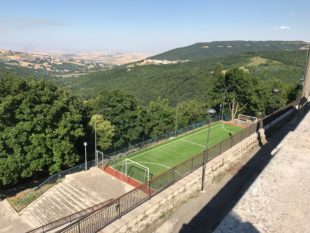If you leave now, you can still catch American Airlines Flight 718 direct from Philadelphia to Rome. The plane is Airbus 330, so you’ll be wise to avoid the narrowing seats in the rear and, of course, anything near the bulkhead or bathroom.
If you miss the flight, don’t worry: there’s another one tomorrow and every day thereafter.
Once you land, you’ll have to wait an hour or two in the mind-numbing inanity that is the rental car line at the Rome Fiumicino Airport. A mantra of nihilism and peaceful patience will be your best friend there, so use it, get yourself a car (skill with a stick shift is a prerequisite), and head south past Naples. The rolling hills and breathtaking mountains will do their best to distract you, so if you make it to Cilento, know you’ve gone too far. Otherwise, get off the Autostrada and take your pick of the countless “this can’t be the way” roads that head into the mountains.
In no time at all you’ll have gotten sufficiently lost. State roads will have given way to local routes which will have given way themselves to worn paths that will take the air out of the sails of even the most optimistic of voyagers. This is a journey to the middle of nowhere, to the center of the labyrinth, complete with flocks of sheep and cows on asphalt graded like a ski jump and pocked like the face of the moon.
Keep faith and keep going, you’re almost there.
As you nip and tuck your way around impossibly tall wind turbines and up into the woods, you’ll suddenly and perhaps queasily roll your smaller-than-it-even-looks car into the community of Faeto.
Auguri, you made it.
Faeto
Faeto is a 13th century town settled by French soldiers who, after whatever skirmish in which they took part finished, decided against walking the 600 miles or so back home and built a village on top of a mountain instead. From a central church and square, the Faetani built a meandering and spiraling town, a postcard paradigm for Italian hillside village cliches. At its peak, the population was never more than several hundred people and is so remotely located that the locals still speak a provincial French in favor of the national language.
Though unquestionably charming, today Faeto is a forgotten place. Signs only start to show the way when you’re already nearly there, and the only professional jobs are a 45 minute bus ride away. Nothing about the town is unique in that regard, nor is it exceptional; it’s one of a thousand in Italy, and a million towns in the world like it.
Time passes, culture changes, and towns like this just fade away. They’re called “Ghost Towns” for a reason.
In the Italian soccer landscape particularly, Faeto doesn’t exist. Just because the town doesn’t exist, however, doesn’t mean soccer isn’t being played there.
On the east side of town is a terrace from which, when the clouds have broken and the sun shines, you can see the shimmering Adriatic Sea some 100 kilometers away. Just below the belvedere, on what was until recently a forgotten passage between roads is now a small soccer field.
Diamonds in the rough
Faeto doesn’t exist in the Italian soccer landscape. By definition, a place that doesn’t exist can’t or won’t produce the next Buffon, Chiellini, or Totti.
But…
The next great American striker certainly isn’t coming out of “The Oldest City in Texas,” is he? Well, Clint Dempsey already came from there.
Ever heard of Jurupa Valley, California? It’s bigger than the city where Uruguayan striker Edinson Cavani was born.
This observation is not new. Countless publications, the Wall Street Journal included, have observed this phenomenon: more professional athletes come from small towns than population alone would suggest. The reason is simple.
If a place doesn’t exist, then the people there are free to do as they please with all of the time in the world.
In this forgotten place, for five days in the dead heat of August, the field was full of preteen players fully engaged in organized and fluid small-sided games.
Morning, noon, and night for five days: Cruyff turns, successful attempts at one-twos and tiki taka, and fully-kitted keepers laying out on turf-atop-concrete in the southern Italian summer sun.
Faeto doesn’t exist in the Italian soccer landscape. And yet, here it is. Here they are, playing until infinity.
Money well spent
In all likelihood, the next great Italian player probably isn’t coming from Faeto, in the same way that the next great player in any sport in any country probably isn’t coming from any particular place.
Laying the foundation, broadly and indiscriminately, in small towns and big cities, with private money and public alike, in city centers and every forgotten corner of the country, that will ensure that the next great Italian player comes at all. The source is irrelevant.
Is this a story about the Union and their failure to meaningfully invest in soccer infrastructure beyond a stone’s throw of their remote stadium? Is it a story instead about American soccer’s Pay to Play problem, the recent failures of the Men’s National Team, or the Federation’s $100 million cash position? It could be.
It’s mostly just a story about a soccer pitch in the middle of nowhere.


This was great, Chris. Could have been in the New Yorker.
Great story, Chris. Looked at Faeto on Google Earth. Wow, it is out there.
As of 2010, 14,257, the population of a small Pennsylvania town known as Hershey.
.
Wonderful job Chris. Just the drive alone sounds amazing.
Great piece. Thanks.
Brilliant. Heartwarming. Persuasive. Makes you want to see it for yourself. Highest marks. Proof that PSP fosters the best writers.
I feel like I was there…thanks for taking me along!